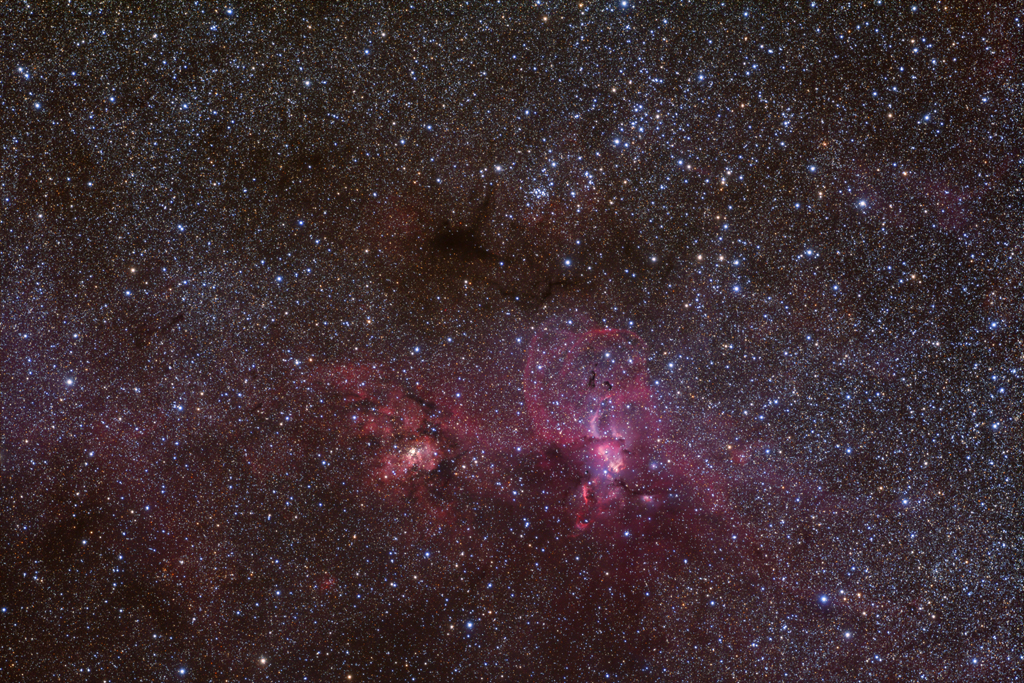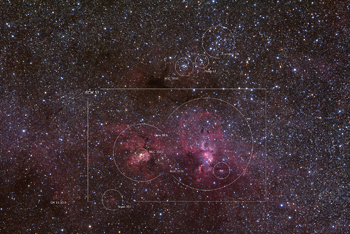 |
CHAMÄLEON + ONJALA OBSERVATORY DeepSky | SITEMAP HOME CHAMÄLEON |
|
 |
|||
| « back to overview Nebulae | Load higher resolution (1200 x 1800 Pixel 2800 x 2100 Pixel) | Object description |

East ( 3.5 degrees ) of the Carina Nebula - NGC 3372 - is RCW 57, a large region of emission nebulae. Within RCW 57 are two other large star forming regions, at very different distances from the Solar System, in the middle of the southern Milky Way. The luminous gas nebulae around NGC 3576 on the right-hand side of the image are about 9000 light years away from Earth. The two arc-shaped structures in the northern part of the nebula are particularly striking. The intense stellar winds of the massive young stars in the nebula centre create the bubble-like structures in the gas of the nebula.
The nebula with the catalogue designation Gum 38 b around the extremely luminous open star cluster NGC 3603 on the left side of the image is with 23 000 light years more than twice as far away as NGC 3576. The color of the nebular region is clearly shifted to orange-reddish compared to NGC 3576. This is caused by the much stronger interstellar absorption of dust due to the longer light path between the star cluster and the nebular masses to the Solar System.
NGC 3603 lies at a distance of about 23,000 light years in the Carina Sagittarius spiral arm of our Milky Way. It is a very bright open star cluster, known to contain the largest concentration of massive stars ever found in a cluster in our Galaxy. In the center is a Wolf Rayet multiple star system called HD 979 50, which is at an advanced stage of stellar evolution, with individual stars often having more than 20 solar masses. NGC 3603 contains several Wolf Rayet stars and many stars with more than 100 solar masses. Visually NGC 3603 shows about 30 stars, high resolution images with large telescopes show several hundred stars. Its physical diameter is about 20 light years. According to Trumpler, the star cluster is classified as type I 1 p n and its age is estimated to be only 2 million years. NGC 3603 was discovered on 14 March 1834 by the British astronomer John Herschel. The year 1834 was one of the most productive and successful years of the British astronomer in South Africa.
Gum 38 b, together with NGC 3603, is an area of very intense star formation. When the young stars slowly begin to shine in the visible spectral range, the H-II regions surrounding the stars also become visible. These regions then glow due to the interaction between the ultraviolet radiation emitted by the young and hot stars and the hydrogen gas in the clouds surrounding them. H-II regions can have diameters of several hundred light years. Gum 38 b, surrounding NGC 3603, is the most massive star formation region in our Milky Way.
 |
NGC 3576 is also located in the
Carina Sagitarius spiral arm of our Milky Way, but compared to NGC 3602 it is
only about 9,000 light years away from Earth and is therefore much closer to
the Solar System than NGC 3603, although it appears as its neighbour in the
image. NGC 3676 is the brightest part of the Emission Nebula, other areas have
NGC catalogue numbers 3584, 3579, 3592, 3581, 3501, 3506,3576 and GN 11.09.3.
NGC 3576 is remarkable because of two large objects that resemble the curved horns of a sheep ram. These strange filaments are the result of stellar winds emanating from hot and young stars in the central region of the nebula. They have transported dust and gas hundreds of light-years outward. In the upper part of the nebula, two dark silhouettes are visible, so-called Bok globules. These are areas where new stars could form in the future. Such globules can also be found in other H-II regions, e.g. in IC 2944. NGC 3576 was discovered on 16 March 1834 by John Herschel. « The annotated image shows the size comparison with the moon. |
NGC 3590 is an open star cluster, anch Trumpler classified as type II 1 p. With a distance of 5400 light-years it is much closer to the Solar System than NGC 3576. visually it shows about 20 stars, the stars are estimated to be about 30 million years old. NGC 3590 was discovered by John Herschel on 4 February 1835.
Little physical data is known about Trumpler 18, even though it is prominent and bright. With a distance of about 8000 light years and an estimated age of the stars of about 25 million years it seems to belong to the region of NGC 3576.
 |
 |
 |
 |
 |
 |
 |
| Sun | Moon | Solar System | DeepSky | Widefield | Miscellaneous | Spec. Projects |